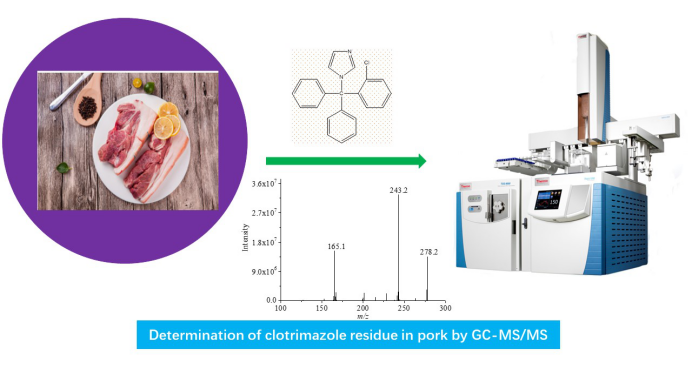Recently, Professor Han Chao's team in the School of Biology and Environmental Engineering has made an important breakthrough in the field of food safety testing, with a series of research results published in LWT-Food Science and Technology (2021, 151, 112101, CAS 1), LWT-Food Science and Technology (2021, 144, 111248, CAS 1), Food Analytical Methods (2021, 14(1): 1-9 and Food Analytical Methods, 2021, 14(2): 237-249, CAS 2).
Octopamine is an alkyl polyamine fungicide developed in China. China's GB2763-2021 "Maximum Residue Limits of Pesticides in Food" provides residue limits for octopamine in tomato, pepper, apple, cottonseed and brown rice, which are 0.5, 0.2, 0.1, 0.1 and 0.05 mg/kg respectively, but due to the lack of a standardised method for the detection of octopamine residues, residues of paclobutrazol, the lack of standardised residue test data and the lack of complete toxicological conclusions or dietary consumption data, only provisional limits have been set. There are no overseas limits for octopamine. In order to strengthen the regulatory effectiveness and fill in the gaps in testing methods, it is necessary to establish a rapid, sensitive, simple and accurate method for the determination of phoxim residues in products of plant origin.
Prof. Han Chao's team optimised the liquid phase separation conditions, pretreatment extraction and clean-up conditions for the strong surface adsorption and molecular structure of phoxim, and established a UPLC-MS/MS method for the determination of phoxim residues in tomatoes, peppers, apples and cotton seeds, and made great progress. The related research results "Determination of Xinjunan Pesticide Residue in Foodstuffs of Plant Origin by a Modified QuEChERS Method and Ultra Performance Liquid Chromatography-Tandem Mass Spectrometry" was published in a recent issue of LWT-Food Science and Technology (2021, 151, 112101, CAS 1), with ZJSRU as the first author and Professor Han Chao as the first author of the paper.
Clotrimazole is a broad-spectrum imidazole anti-fungal drug, which is a synthetic antibacterial agent for the treatment of fungal infections and has a good antibacterial effect on a variety of fungi, especially Candida albicans. Clotrimazole belongs to the second generation of imidazole anti-fungal drugs, and in 1981 along with miconazole, ketoconazole, econazole and other anti-fungal drugs that were marketed in the United States. Accelerated solvent extraction has the advantages of high extraction efficiency, less solvent used and good reproducibility. Gas chromatography-tandem mass spectrometry (GC-MS/MS) combines the efficient separation efficacy of chromatography with the high sensitivity and strong anti-interference monitoring capability of mass spectrometry to achieve accurate determination of targets in complex matrix backgrounds.
Professor Han Chao's team has carried out GC-MS/MS for the determination of clotrimazole residues in animal-derived foodstuffs, and the related research results Accelerated Solvent Extraction-Gel Permeation Chromatography-Gas Chromatography- Tandem Mass Spectrometry to Determine the Residues of Clotrimazole in Foodstuffs of Animal Origin. Tandem Mass Spectrometry to Rapid Detection of Clotrimazole Residue in Animal-derived Food was published in a recent issue of LWT - Food Science and Technology (2021, 144, 11). Technology (2021, 144, 111248, CAS 1), of which Prof. Han Chao from ZJSRU is the first author.
Prof. Han Chao's team also developed a high throughput, accurate and sensitive method for the determination of four amide fungicides in grape wine and fipronil, and its related metabolites in food of animal origin. Chromatography coupled with tandem mass spectrometry and Detection of Fipronil and Four Metabolites in Foodstuffs of Animal Origin using a Modified QuEChERS Method and GC-NCI-MS/MS were published back-to-back in the TOP journals Food Analytical Methods, 2021, 14(1):1-9 and Food Analytical Methods, 2021, 14(1):1-9. Methods, 2021, 14(2): 237-249 (CAS Zone 2 journal), with Prof. Han Chao from ZJSRU as the first author of the paper.
Professor Han Chao's team has been working on the research and development of sensitive, specific and high-throughput detection technologies for food and environmental safety testing and risk analysis, and has established environmental pretreatment and detection and confirmation methods for a wide range of chemical contaminants in food and the environment, and has made a series of research advances.


This series of work was supported by funding from the Zhejiang Provincial Science and Technology Department Public Welfare Research Program (LGF21C200001), Zhejiang Shurian University Basic Research Business Fund for Provincial Universities (2020XZ008) and Zhejiang Shurian University Talent Introduction Project (2019R024).
Full text link.
https://doi.org/10.1016/j.lwt.2021.112101
https://doi.org/10.1016/j.lwt.2021.111248
https://doi.org/10.1007/s12161-020-01844-x
https://doi.org/10.1007/s12161-020-01872-7






